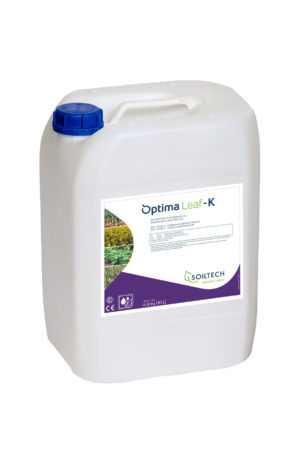Of all the nutritional elements for plants, potassium (K) plays a special role. After nitrogen (N), potassium is the most vital nutrient that is absorbed by plants through the roots. Depending on the crop variety and type of soil, the annual application of potassium can be up to 300 kg/ha K2O! However, unlike the other macro elements (nitrogen (N), phosphorus (P), sulphur (S), calcium (Ca) and magnesium (mg)), potassium is not utilised as a building block for organic molecules. So why do plants need so much potassium?
The role of potassium
Potassium is essential for multiple, but also highly diverse functions in the crop, including:
- Moisture management
- Transpiration
- Regulation of the cellular acidity (pH)
- Activation of enzymes
- Production of protein
- Photosynthesis
- Transport of sugars
The above points clearly demonstrate that a potassium deficiency will cause crop growth to grind to a halt. Potassium can therefore justifiably be seen as the lubricant for a smoothly operating machine.
Potassium not only contributes to a better yield; it also enhances the quality of the crop to be harvested. In addition to promoting flavour and colour, potassium also boosts the post-harvest life of the crop. In potato crops, potassium has been shown to play a vital role in preventing bruising sensitivity, the bruises on tubers caused by impact during-post- harvest processing.
Potassium fertilisation aligned with demand
Due to the high potassium demand of many crops, the majority of potassium should be taken up through the roots. Because potassium is a highly mobile element in the plant, the large amounts of potassium can be transported easily to all parts of the plant. But potassium is also very mobile in the soil, which makes it susceptible to leaching which may lead to a deficiency. In addition, potassium uptake via the roots is only possible if the soil contains sufficient moisture. The last three years have been characterised by extremely dry summers, but also very mild and wet winters. This means that potassium uptake via the roots has been severely disrupted in many crops. The value of additional foliar applications of a potassium fertiliser during the season has been proven.
Recommendations:
During the first half of the season, most crops can uptake sufficient potassium from the soil. However, the peak demand for potassium falls precisely in the second half of the season, when the bulb, tuber or fruit needs to start bulking. Optima Leaf-K should therefore be applied at this bulking stage.
The figure below shows the yield after a series of applications of Optima Leaf-K as a supplement to the standard fertilising schedule.

Optima Leaf-K is a specially formulated potassium fertiliser that contains potassium ions, among other elements, complexed to citrate. Citrate is an organic molecule, to which the free potassium ions bind by a charging reaction. Optima Leaf-K therefore does not contain free salts that can react with active substances found in crop protection products. In addition, Optima Leaf-K is pH neutral and not aggressive for the crop, making it an ideal potassium to combine with crop protection products.
Apply Optima Leaf-K on arable crops at least 3x at a dosage of 5 l/ha, or alternatively 5x 3 l/ha, at an interval of 1-2 weeks. For other crops, including fruit, vegetables and ornamental crops, we recommend applying Optima Leaf-K 6x at a dosage of 5 l/ha in the run up to harvest.

